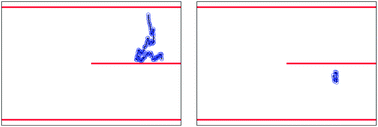Transport of DNA in hydrophobic microchannels: a dissipative particle dynamics simulation
Abstract
In this work, we numerically study a new means of manipulating single DNA chains in microchannels. The method is based on the effect of finite slip at hydrophobic walls on the hydrodynamics and, consequently, on the dynamics of the DNA in microchannels. We use dissipative particle dynamics to study DNA transport as a function of chain length and the Reynolds number in two dimensional parallel plate channels. We show how an asymmetric velocity profile in a channel with hydrophobic and hydrophilic walls can be used to manipulate the location of the DNA molecules. Using this effect, we propose a simple arrangement of hydrophobic and hydrophilic strips which can be exploited to separate long and short DNA chains.


 Please wait while we load your content...
Please wait while we load your content...